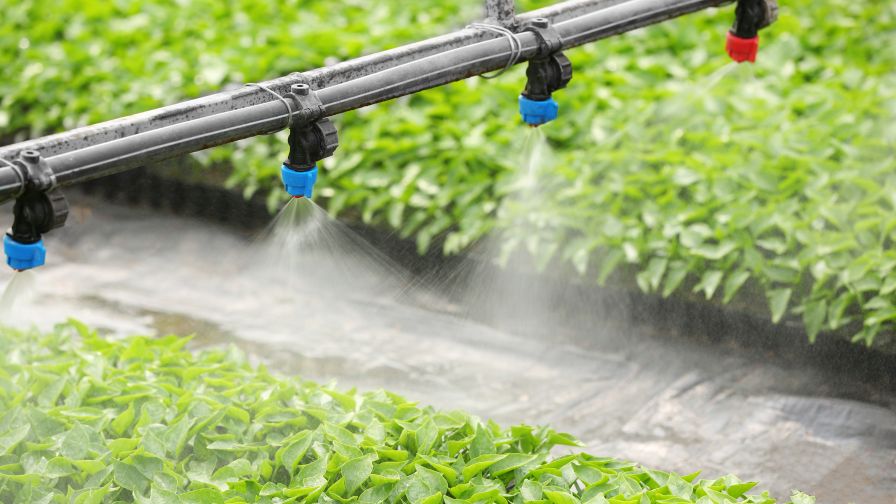Growers Responding to Water Challenges with Improvements in Efficiency
 Everyone knows that water is a precious resource. With ongoing droughts in the West and Southeast, growers are learning how to cut back on their water use. Federal, state, and local regulations govern how water can be treated, reused, and released, and the cost of water keeps going up.
Everyone knows that water is a precious resource. With ongoing droughts in the West and Southeast, growers are learning how to cut back on their water use. Federal, state, and local regulations govern how water can be treated, reused, and released, and the cost of water keeps going up.
Growers are facing this problem head-on with a diverse array of viable options. The key is to use less water and reuse as much as possible. Growers, researchers, advocates, and other industry professionals are coming together to reduce their water use.
Clean WateR3 Educates Growers
Clean WateR3 is a federally funded Specialty Crops Research Initiative grant focused on outreach to help growers reduce, remediate, and recycle irrigation water. Dr. Sarah White at Clemson University managed the grant team and Dr. Paul Fisher at University of Florida continues to educate growers. The grant was completed in 2019 but Dr. Fisher keeps the website, CleanWater3.org, up to date with helpful information for growers.
“Our next phase of this project is looking at water treatment technologies that we can scale up to help growers either treat water that is circulating inside their greenhouses, or if they have to discharge water into the environment, there are technologies like constructed wetlands and bioreactors that can take out nitrogen, phosphorous, and pesticides,” Fisher says.
In late 2022, Fisher taught an online course on water quality and treatment with 95 growers in the class.
There are a couple of key differences between indoor and outdoor production when it comes to water, Fisher says. Outdoors, rainfall is often the biggest part of irrigation. Outdoor growers focus on avoiding overwatering, managing water in retention ponds for reuse, and stopping stormwater from seeping into the ground.
Indoor growers focus on recirculating nutrient solutions. To avoid dumping a nutrient solution down the drain, growers sanitize, rebalance nutrients, and reuse the water. Fisher says he is currently working on projects with two water treatments, cold plasma and ozone, to sanitize the recirculating nutrient solution.
“The advantage is that they both break down into oxygen and water, so there are no harmful chemicals,” Fisher says.
Even though water is more scarce and costly in the West, Fisher says all growers see the value of water and fertilizer, which has greatly increased in cost. Indoor growers and hydroponic growers do not want to waste the nutrients in their water.
“For so many growers now, access to water resources is limited. Growers really do understand the value of being able to capture and reuse,” Fisher says. “It’s not just California, it’s everywhere in the U.S.”
Fisher says growers are willing to invest in systems to clean and recirculate water, but sometimes the capital investment is high. In this case, growers can do a cost-benefit analysis for infrastructure to capture rainfall from the roof of a greenhouse or build a retention pond.
“A combination of the costs of water and fertilizer, access to water resources, and increasing regulations about the quality of water and amount that can runoff your property, all of those are major drivers for this investment,” Fisher says.
Dr. Tom Fernandez at Michigan State University is currently leading an effort to apply for a grant to further research water conservation and water treatment. Researchers are seeking letters of support from industry stakeholders to submit with their grant application. Interested parties may contact Fisher for more information at [email protected].
Climate Ready Landscape Plants
To reduce water use, a team of university professors are researching drought-tolerant plant varieties. Dr. Lorence Oki, Cooperative Extension Specialist at University of California, Davis, heads up the Climate Ready Landscape Plants research project. Six western universities are working with USDA grant funding to research which varieties perform best with little water in two-year trials. Oki says the universities have tested about 250 varieties so far.
Some of the results of the field trials are surprising, Oki says. For example, consumers tend to think of roses as plants that require a lot of water. But some cultivars require little water.
“Most of information available on plant water use is anecdotal and not based on research,” Oki says. “With our field research, we can get some real science behind this.”
Although the trials do not only include new varieties, the universities ask plant distributors to submit new plants for testing. Ball Ornamentals, Star Roses and Plants, and others have been strong advocates, Oki says.
Oki says the major impact is on the end consumer. The university trial gardens host three open house field days throughout the year and invite horticulture professionals to rate the plants. Landscape designers and architects value seeing how the plants perform after some time in the ground instead of seeing them in a container at a nursery. Water agencies also use the field trial results to promote landscape water conservation. Breeders are adding this information to their marketing materials, too.
“The plant developers are starting to use our information in their marketing materials,” Oki says. “Kurapia, a low water use groundcover, says ‘UC tested.’”
Green Acres Nursery and Supply, a regional retail nursery with locations in California and Texas, receives requests from landscape designers for plants they have seen in the UC Davis trials.
“That’s part of the strategy — to invite landscape professionals,” he says. “They can request these plants to be grown and sold to consumers. In the end, the objective is to have landscapes that use less water.”
Advocate for Change
Chris Udall, Executive Director of the Agribusiness and Water Council of Arizona, says a 23-year drought affecting the Colorado River is causing a squeeze. Despite some bright spots, Arizona, along with other basin states, is in a crunch due to water and hydropower availability. Farmers and growers want to continue to operate, he says, but they need some compensation to turn a profit.
“We’re not looking for a handout,” Udall says of the need for long-term, low-interest loans. “We want a chance to bring our infrastructure into the 21st century and make our facilities more resilient to drought.”
For example, pumping water leads to higher energy costs for outdoor and indoor growers. Greenhouse growers are looking for new, innovative solutions to produce more crops with less water, such as moving toward drip and pressurized irrigation systems.
The Colorado River was budgeted to have 16.5 million acre-feet of water, but there is currently only 12 million acre-feet of water flowing, according to Dr. Jeff Silvertooth, Professor of Soil, Water, and Environmental Science at the University of Arizona. Udall says basin states have not been able to reach an agreement on how much water each state will use, but they are continuing the dialogue.
“Many think that the federal government may step in and require mandatory cuts. What that looks like is anybody’s guess. Others are saying this is going to be a combination of voluntary and mandatory cuts,” Udall says. “It’s difficult when you’re used to so many acre-feet coming through the system and we’re not anywhere near that right now. It’s definitely going to be a pain felt by everyone.”
Udall recommends that growers continue to be innovative in their water-use practices. By trying new things, they may find irrigation systems that save on water or find better ways to treat and reuse their water. Growers are also welcome to join the Agribusiness and Water Council of Arizona, along with universities, water and electrical districts, and consultants, to collaborate and promote everyone’s best interests.









